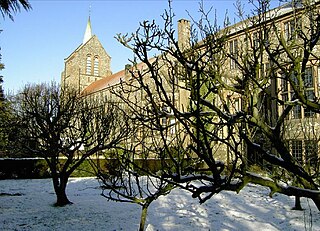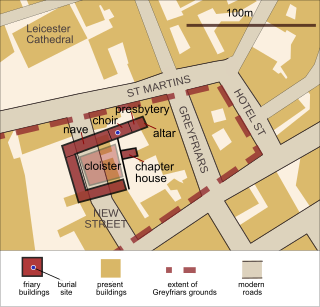Related Research Articles

Greyfriars is a Roman Catholic friary and parish located in East Oxford, which until 2008 was also a Permanent Private Hall of the University of Oxford. Situated on the Iffley Road in East Oxford, it was one of the smallest constituent halls of the university. Its status as a Permanent Private Hall (PPH) referred to the fact that it was governed by an outside institution, rather than by its fellows as is a College.

Greyfriars Church is an evangelical Anglican church, and former Franciscan friary, in the town centre of Reading in the English county of Berkshire. The church forms part of the Church of England's Diocese of Oxford.
Greyfriars was a monastic house in Bedford, England. The house of the Grey Friars was founded either by Mabilea de Plateshull or John St. John during the reign of King Edward II, and their church was dedicated on 3 November 1295. The date of the arrival of the Franciscans in the town is not known.
The Franciscan Friary of Southampton was founded c. 1233. It occupied a south-eastern area of the city, within the walls and adjacent to God's House Tower. The friary was notable for its water supply system, which supplied water for use by the friars themselves and by the other inhabitants of Southampton. The friary was dissolved in 1538 and the last remains were swept away in the 1940s. The site is now occupied by Friary House. Elsewhere, remnants of the extensive water supply system still survive today.

Various monasteries and other religious houses have existed at various times during the Middle Ages in the city of Exeter, Devon, England.
Greyfriars, Beverley was a Franciscan monastery in the East Riding of Yorkshire, England. It was established before 1267, probably by John de Hightmede, but the exact date is not known. Originally located within the town walls near today's St Mary's Terrace, it was moved outside Keldgate, near Westwood, about 1297. Having fallen in disrepair in the 1330s, the knight Sir John Hotham of Scorbrough provided funds for its rebuilding in the 1350s. Several members of his family were buried there later. The friary benefitted further from grants made by nobles and merchants. The friars acknowledged royal supremacy in 1534, and the monastery was surrendered to the Bishop of Dover on 25 February 1538–39. Although no buildings of the friary have survived, it is remembered by the street name "Greyfriars Crescent".
Dorchester Friary, also known as Dorchester Priory, was a Franciscan friary formerly located in Dorchester, Dorset, England.

Greyfriars is a country estate in Winchelsea, East Sussex, England. It contains a ruined medieval monastery and church and a 19th-century house.

Greyfriars, Gloucester, England, was a medieval monastic house founded about 1231.

Greyfriars, Stamford was a Franciscan friary in Lincolnshire, England. It was one of several religious houses in Stamford suppressed in the Dissolution of the Monasteries.

The Greyfriars, Lincoln was a Franciscan friary in Lincolnshire, England. The surviving building is the remains of the infirmary of the friary, built of dressed stone and brick and dating from c.1230, with mid 19th century additions.

Boston Friary refers to any one of four friaries that existed in Boston, Lincolnshire, England.

Greyfriars, Worcester is a Grade I listed building in Worcester, England. Its location near to a former friary of the Franciscan order of Greyfriars has in the past led to speculation that it was constructed as their guest house, but it is now believed to have been built as a house and brew-house c.1485 for Thomas Grene, brewer and High Bailiff of Worcester from 1493-1497. It has been in the ownership of the National Trust since 1966.

Greyfriars, Leicester, was a friary of the Order of Friars Minor, commonly known as the Franciscans, established on the west side of Leicester by 1250, and dissolved in 1538. Following dissolution the friary was demolished and the site levelled, subdivided, and developed over the following centuries. The locality has retained the name Greyfriars particularly in the streets named "Grey Friars", and the older "Friar Lane".
Newark Friary, also known as Newark Greyfriars, and Newark Observant Friary, was a friary of the reformed "Observant Friars" of the Franciscan Order, located in the town of Newark, Nottinghamshire, England. The friary as founded by Henry Tudor c. 1499, and dissolved by his son, Henry VIII, in 1539.
Greyfriars, Dumfries, was a friary of the Friars Minor, commonly known as the Franciscans, established in Dumfries, Scotland. Following dissolution the friary was demolished and the site levelled. The locality has retained a reference to the friary in the street named "Friars Vennel". The present neo-Gothic Greyfriars was built from 1868 and is located at the site of the former Maxwell's Castle at the top of High Street.
References
- 1 2 Historic England Research Records: Exeter Greyfriars
- ↑ A.G. Little and R.C. Easterling: The Franciscans and Dominicans of Exeter. History of Exeter Research Group, Monograph No. 3. A. G. Wheaton, 1927